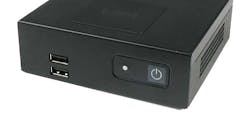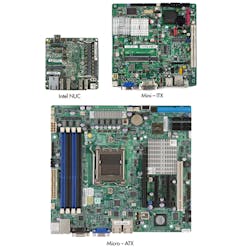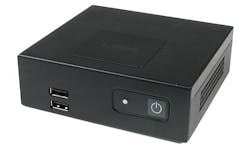This file type includes high resolution graphics and schematics.
These days, increasingly universal standards have made building a computer easier than ever. But to begin you must first establish your wants and needs. The easiest thing to do is to choose either the standard ATX or Micro-ATX form factor, then cherry-pick the parts you want to accompany the board. But sometimes even a Micro-ATX system can be too bulky. Fortunately, two smaller form factors are available: Mini-ITX, which has been on the market for quite a long time, and Intel’s new NUC (Next Unit of Computing) platform (Fig. 1).
Table Of Contents
Historically, if you wanted a small form-factor PC, your first choice probably would have been Micro-ATX, which was introduced in 1997. Micro-ATX motherboards made very few sacrifices in terms of features and expandability, so they balanced well the desires of a smaller design and those of maintaining a large feature set.
Later, the even smaller Mini-ITX platform gained a lot of popularity for mostly the same reasons. But even as the Mini-ITX continues to gain popularity, Intel has developed the NUC platform, which will do everything many users require. So what’s the difference between NUC and Mini-ITX, and why would you choose one over the other?
Mini-ITX was first developed in 2001, but it didn’t become popular for consumers until 2008, when Mini-ITX 2.0 came out. The Mini-ITX 2.0 specification gave Mini-ITX motherboards a PCI Express x16 slot instead of a legacy PCI slot, allowing users to add high-end graphics cards or other expansion cards that worked only on the PCI Express interface. While it sacrificed some features people had come to love, the integration of many other features rendered a large number of expansion slots redundant to most users.
For example, further in the past it was not uncommon to have a network card, a sound card, and a graphics card, all in the form of expansion cards. But these features have since been placed on the motherboard, eliminating the need for many expansion cards. The only difference in features on the typical current Mini-ITX platform are the lack of large, elaborate VRM designs; occasionally a lack of some connectivity ports; and the number of memory slots, which is typically two where it would be four on most Micro-ATX and ATX size boards.
Mini-ITX can cater to a huge number of customer types, particularly because of the enormous flexibility of the form factor. Like any standardized motherboard form factor, there are motherboards with high-end chipsets and support for some of the most powerful CPUs.
For example, you can buy a Z77-based Mini-ITX board and drop an Intel Core i7-3770K into the LGA1155 socket. This combination yields considerably more processing power than the average consumer will ever need, and it’s also enough for enthusiast or professional users. Get a small enclosure and add a graphics card to this configuration and you can have yourself a very powerful, yet tiny, gaming machine.
On the other end of the spectrum, though, it’s also possible to build a simple tiny computer that will manage everyday tasks easily. Take a Mini-ITX board with a soldered low-power CPU and mount it in a thin, light enclosure. You won’t even have to break the bank to get one. Invest a couple extra dollars and you have a system that works as a very capable media center, purely for media playback and consumption.
While a Mini-ITX computer is small enough for many people, sometimes an even smaller machine is required. Developed and produced by Intel, the NUC (Next Unit of Computing) platform boasts a tiny form factor. NUC systems measure just over 4 by 4 in. and are about 1.5 in. thick. This truly tiny form factor allows you to hide the PC just about anywhere—behind the TV on a Video Electronics Standards Association (VESA) mount, in a corner behind a speaker with a bunch of cable-clutter surrounding it, or subtly on your TV stand, between the base and the screen bezel, but not protruding out past the bezel.
Micro-ATX boards, by contrast, are up to 9.6 by 9.6 in. and can be placed in a huge scope of enclosures, ranging from thinner home-theater PC (HTPC) enclosures to much bigger enthusiast enclosures. The same goes for Mini-ITX, which measures 6.7 by 6.7 in. Of course, these boards are far more difficult to mount discreetly than the NUC.
Such a small form factor comes at a cost, though, and in more ways than one. Intel’s NUC systems retail for around $300, and this is only the bare bones configuration—memory and storage aren’t included. Depending on your needs as a buyer, you still might want to add a mini PCI-Express Wi-Fi card, a DDR3 small-outline dual-inline memory module (SO-DIMM), and a small to large mSATA solid-state drive (SSD).
The other cost is the feature set. The Intel NUC systems will only ship with two different low-power Ultrabook CPUs: a low-power Intel Celeron CPU or the more powerful Intel Core i3-3217U. In practice, you probably won’t want less than the Core i3-based model, lest you overwork your system. Furthermore, the system’s CPUs cannot be upgraded, nor is there any room for real practical expansion.
Lucky for me, I live right around the corner from an industrial embedded computer company, Logic Supply, which was kind enough to lend me one of its i3-based LGX AG960 NUC systems (Fig. 2). Logic Supply’s systems are geared a bit more toward light industrial use, but perform well as consumer products, too. The LGX AG960 NUC system comes with four USB 2.0 ports—one more than the standard reference design. So, I could leave the device running throughout the day and use it as a printer-server.
Intel produces the NUC platform, though, and no other firms manufacture the NUC boards. Other manufacturers only can make enclosures, Wi-Fi cards, mSATA SSDs, and memory for the NUC platform. And of these, only the enclosure needs to be specific to the NUC platform. Logic Supply isn’t the only company to make enclosures for the NUC platform. Other companies including Streacom, SilverStone, and Tranquil PC build NUC enclosures, and for good reason.
The standard Intel NUC enclosure has problems coping with the thermals (more on that here). To test the system, I installed Windows 7 and then XBMC so I could comfortably use the device to replace my Mini-ITX media center for a few weeks. My experience has given me some new insight into the platform.
First, the lack of dedicated graphics power is inconvenient. While the integrated HD4000 graphics does manage Blu-ray quality MKV files quite well, playing 1080p videos on YouTube wasn’t fluid. It was jumpy at best. Also, 720p played back fine, but if I had a number of other tabs open beside the video, I could already tell that the machine was having trouble coping. Note that I had the NUC filled with 8 Gbytes of DDR3-1333 memory and a 256 Gbytes mSATA SSD, so the memory and storage space certainly weren’t the bottlenecks. (This could also be more of a problem with YouTube than with the hardware.)
All that said, the system would be more than adequate for everyday tasks like checking your e-mail, your bank statement, and basic social media administration. Of course, given the problems that the platform is known to have with thermals, I had to see if Logic Supply had managed to solve them with its NC200 NUC enclosure. After running Prime95 for a number of hours and the CPU temperature leveling out at 80°C, with my BIOS settings optimized for silent operation, I concluded that the thermal problems were not an issue here.
The only way to get audio out of the NUC system is through the HDMI ports, through your receiver or television. You can buy an external USB sound card, but that would defeat the purpose of having an extra tiny PC. As such, it is also possible to increase the graphics power. You can purchase the NUC system with the Thunderbolt port, sacrifice one of the two HDMI ports along with Gigabit Ethernet, get an external Thunderbolt to PCI-Express expansion slot, and slot a graphics card in there. But the problem remains the same. That said, while the Intel NUC platform might be too constrained for certain consumer use, it does have its use in the industrial market.
Industrial use is quite different from consumer use. While “industrial” is a broad term, single systems in industrial applications often get used for much more specific tasks, unlike in the consumer market. In the consumer market people usually have a single PC to fulfill all their needs, from writing e-mails and social networking to heavy gaming. While in the industrial segment there are certainly applications that require much more processing power, many tasks can be completed using a rather basic system.
That’s where the Intel NUC platform comes in. It is a basic system, but also much smaller, more discreet, and more energy-efficient than the Mini-ITX (or comparably sized platform). For an application like point-of-use/kiosks, a typical gaming system would be absolute overkill—not only unnecessary, but, in terms of energy consumption, expensive.
So the Intel NUC platform has its uses in certain markets, and it excels in them. For some specific industrial applications (think digital signage and advanced kiosks), NUC shows promise. But right now, for high-end consumer use anyway, the platform is still too limited and weak.
Perhaps these issues will be solved sometime in the near future. But unless the size of the machine is a deal-breaker, the Mini-ITX platform is the way to go for most consumer use. It offers more flexibility and can thus cater to a much greater audience. It is flexible enough to create a compact low-profile system still small enough to mount behind TVs and has power enough for most anything, all the way up to extreme liquid-cooled gaming beasts still small enough for convenient transport.
So, what’s the difference between Mini-ITX and Intel’s NUC platform? There are so many differences, it’s almost easier to ask what’s not different between them. Though their uses sometimes overlap, the two are so physically (and often practically) different that they really shouldn’t even be compared to each other. In the end, you have to consider your needs and ask yourself which platform is best.
This file type includes high resolution graphics and schematics.




